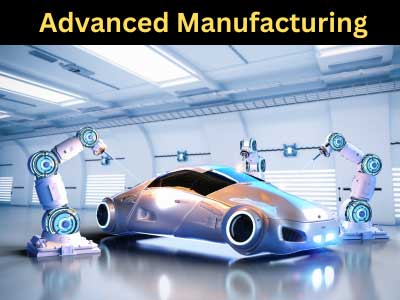Key Takeaway
The primary objectives of advanced manufacturing technology are improving efficiency, enhancing quality, and reducing costs. Using technologies like AI, IoT, and robotics, manufacturers can streamline processes and boost productivity.
Another key goal is flexibility, allowing manufacturers to quickly adapt to changing market demands. These technologies also help reduce waste, ensuring sustainability by optimizing resource use. Advanced manufacturing focuses on delivering high-quality products consistently while lowering operational costs. Implementing these technologies allows manufacturers to remain competitive and sustainable in a fast-paced industry.
Increasing Efficiency and Reducing Costs in Production
One of the foremost objectives of advanced manufacturing technology is to increase production efficiency while minimizing costs. Technologies like automation, robotics, and artificial intelligence (AI) are central to achieving these goals. Automation streamlines repetitive tasks, reduces human error, and increases the speed of production, which directly reduces operational costs.
For instance, robotics in production lines can operate continuously without fatigue, ensuring that output remains steady and reliable. AI-driven systems monitor processes in real-time, identifying inefficiencies and optimizing workflows. This reduces downtime, improves resource allocation, and enhances machine utilization rates.
Moreover, technologies like 3D printing reduce material waste by producing only what is needed for specific tasks, further cutting costs. By adopting advanced manufacturing systems, businesses can achieve cost-effective production while maintaining high-quality standards.

Enhancing Product Quality Through Precision Engineering
Another key objective of advanced manufacturing technology is to improve product quality through precision engineering. AMT enables manufacturers to meet stringent quality standards by integrating computer-aided design (CAD), computer-aided manufacturing (CAM), and real-time quality monitoring systems into their operations. These technologies ensure that each product is made to exact specifications, which is particularly important in industries such as aerospace, healthcare, and automotive manufacturing.
For example, sensors embedded in machines continuously collect data on the production process, detecting any anomalies that could affect product quality. This enables real-time adjustments, ensuring that potential defects are addressed before they become costly issues. Additionally, machine learning algorithms analyze historical data to predict and prevent future quality issues, making the production process more reliable over time.
By leveraging real-time analytics, engineers can make informed decisions that directly impact product quality. The integration of robotics and AI also contributes to greater consistency in production, ensuring that each product is of high quality, whether produced in small batches or mass quantities.
Manufacturers adopting advanced manufacturing technology find that improved precision translates into fewer product recalls, less rework, and lower warranty costs. It also enhances customer satisfaction by delivering reliable, high-quality products, which strengthens brand reputation in competitive markets.
Achieving Flexibility and Customization in Manufacturing
Advanced manufacturing technology provides the flexibility needed to adapt to market changes and enable mass customization, which has become increasingly important in modern manufacturing. Traditional manufacturing systems are often rigid and difficult to modify. However, with AMT, manufacturers can shift between product lines and customize production runs to meet specific customer demands without sacrificing efficiency.
For instance, modular production systems allow manufacturers to quickly reconfigure assembly lines to accommodate new products or variations of existing products. This flexibility is crucial in industries like consumer electronics, where product lifecycles are short, and customer preferences change frequently.
Moreover, technologies like 3D printing and digital manufacturing facilitate the production of highly customized goods. These systems allow manufacturers to create products tailored to individual specifications, meeting consumer demand for personalization. Additive manufacturing technologies, such as 3D printing, also allow for rapid prototyping, enabling manufacturers to bring new products to market faster.
By adopting flexible manufacturing technologies, businesses can respond quickly to fluctuations in demand and offer a more personalized product range. This enhances competitiveness and customer satisfaction in an increasingly customized market.
Reducing Environmental Impact Through Sustainable Practices
In an era of heightened environmental awareness, advanced manufacturing technology is also instrumental in reducing the environmental impact of production. One of the key objectives of AMT is to promote sustainable practices by optimizing resource use, reducing waste, and minimizing energy consumption.
Smart manufacturing systems are designed to be energy-efficient, utilizing real-time data to optimize production schedules and reduce energy use during off-peak hours. Sensors monitor machine performance and energy consumption, identifying areas where energy use can be reduced without compromising productivity. Additionally, manufacturers can incorporate renewable energy sources into their operations, further reducing their carbon footprint.
AMT also contributes to sustainability by reducing material waste. Additive manufacturing, for instance, allows for more precise material use, as components are built layer by layer. This method eliminates excess material and minimizes the waste associated with traditional subtractive manufacturing processes like machining and cutting.
Recycling materials within the production process is another benefit of advanced manufacturing technology. Manufacturers can reuse byproducts and scrap material, creating a more circular economy within their operations. This reduces the environmental impact of manufacturing and contributes to long-term sustainability goals.
Supporting Global Competitiveness in Manufacturing
Advanced manufacturing technology helps manufacturers remain competitive in the global marketplace by enhancing production capabilities, improving product quality, and reducing lead times. In a rapidly evolving global economy, companies need to adopt technologies that allow them to be agile and efficient, while also maintaining high standards of quality.
One of the ways AMT supports global competitiveness is by enabling manufacturers to bring products to market faster. Automation, AI, and real-time data analytics streamline production, reducing the time it takes to go from concept to finished product. This speed is critical in industries where innovation drives success, such as electronics and automotive manufacturing.
In addition, advanced manufacturing enhances supply chain flexibility. Real-time monitoring and predictive analytics allow manufacturers to adjust production in response to disruptions or changes in customer demand. This adaptability reduces delays and ensures that production continues even when supply chain challenges arise.
AMT also enables small and medium-sized enterprises (SMEs) to compete on a global scale. By adopting scalable, cost-effective technologies, SMEs can improve their production efficiency and product quality, allowing them to compete with larger companies. This democratization of technology is leveling the playing field in the manufacturing sector.
